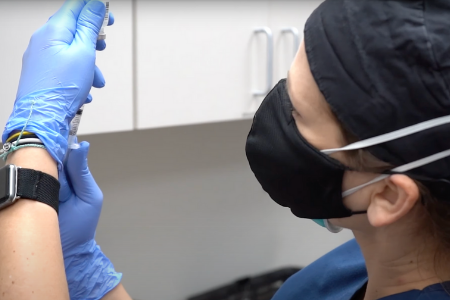You may think that having chronic joint pain in the knees, hips, shoulders, wrists, or other areas is a normal part of life. Like many others, you may have tried over-the-counter remedies to alleviate the pain, only to eventually resign yourself to having “bad knees” or a “bad shoulder.”
We’re here to tell you: It doesn’t have to be this way.
Phuong Bui, MCMSc, PA-C, is a certified physician assistant at AMA Medical Group. She sees firsthand the suffering that joint pain and stiffness can cause. She says, “A lot of our patients have osteoarthritis in the joints—especially in the knees.” To combat this, one of the services AMA Medical Group offers is joint injections. Here’s what you need to know about them.
What Are Joint Injections?
Joint injections, or intra-articular injections, directly apply a mix of anesthetic and corticosteroid into the damaged tissue inside a joint. The anesthetic acts to alleviate pain. The corticosteroid works to lessen the inflammation in the joint, which typically causes some of the pain you’re feeling. Joint injections are less invasive than surgery and can give you some relief from the chronic pain you may have been enduring.
As the body’s largest joint, the knee is a particular target for pain. To alleviate that pain, critical steroid knee injections are done on a routine basis, Phuong says. She continues, “If that doesn’t work, we also have gel injections that replace the synovial fluids to give more cushion and more stability in the knees.”
The joint injection procedure itself takes 20 minutes or so; however, there is an observation period just after the procedure that requires more time. Your medical provider will situate you so you are comfortable for the full duration. Depending on which joint is injected and how easy it is to access the injection site, you may even be able to lie on your back.
Your clinician will typically clean and disinfect the area and may numb the skin with a local anesthetic. The injection will be carefully guided through the use of X-ray or ultrasound technology to ensure the proper placement of the medications. During this process, you may notice some stinging or pressure. It’s important to tell your provider how you are feeling during the procedure.
After the injection, you will relax in the recovery area for 30 minutes or so. Your medical team may ask you to perform a few simple movements to gauge your pain level and mobility. You will likely need someone to drive you home, just to be safe.
Your provider will then give you aftercare instructions to follow for a few days, which will include items like:
- Don’t use a whirlpool, bathtub, or hot tub for 48 hours
- Keep an eye out for signs of infection at the injection site
- Apply ice to the injection site to relieve any pain
Why Would I Need a Joint Injection?
 Joint injections can help alleviate pain in your hip, knee, shoulder, or other joints. It’s a treatment that could help offset the pain from:
Joint injections can help alleviate pain in your hip, knee, shoulder, or other joints. It’s a treatment that could help offset the pain from:
- Arthritis
- Bursitis
- Gout
- Injury
- Repetitive motion joint stress
- Tendonitis
These conditions and the pain they cause your joints can become chronic as the joint breaks down. This can negatively affect your quality of life and mobility to the point where even simple tasks are hard. A joint injection may lessen or stop the pain for a time to help you feel better. While it won’t heal or fix the underlying cause of the pain, it will take it away for a time.
Pain management is an important subset of the healthcare field. Medical professionals strive to individualize pain management therapies by using all of the tools available, including:
- Alternative therapies such as acupuncture, chiropractic, or massage
- Educational workshops to teach pain management techniques
- Light exercise or physical therapy
- Over-the-counter pain relievers such as acetaminophen or ibuprofen
- Weight loss, if weight is a contributing factor to joint pain
Phuong says, typically, joint injections are given, “after you’ve failed conservative therapies with oral medications.” The benefits of a joint injection are pain reduction without requiring surgery. This is particularly helpful if you’re too young to have a hip or knee replacement, but are likely to qualify for one down the line.
How Long Does a Joint Injection Last?
Every patient is different, however, the positive relief you may feel from a joint injection could last up to four months. Some patients feel full pain relief while others say they only feel a lessening of their symptoms.
While you may experience some pain relief immediately, it may take two to seven days for the full effect of the joint injection to be realized. Generally, joint injections are recommended no more than three times per year.
Are There Side Effects of Joint Injections?
Generally, joint injections are quite safe. However, all medications come with the risks of side effects. Larger doses and repeated joint injections could expose you to:
- Damage to cartilage
- Joint infection
- Nerve damage
- Thinning of bone near the injection site
- Weakening tendons around the joint
It’s for these reasons that doctors typically limit the number of joint injections you receive each year, and use these only when other therapies are no longer effective.
Some patients won’t be good candidates for joint injections for a variety of reasons. If you are on blood thinners for other conditions, you should stop taking them for several days before the joint injection. If you have diabetes, cortisone may temporarily raise your blood sugar levels, so this should be carefully monitored.
How Can AMA Medical Group Help Your Pain?
 At AMA Medical Group, our goal is to help with preventative care and medical treatments to help you lead a fuller and more active life. If you’re struggling with joint pain, know that Phuong and the team are ready to work with you to determine the best treatment for long-term relief.
At AMA Medical Group, our goal is to help with preventative care and medical treatments to help you lead a fuller and more active life. If you’re struggling with joint pain, know that Phuong and the team are ready to work with you to determine the best treatment for long-term relief.




